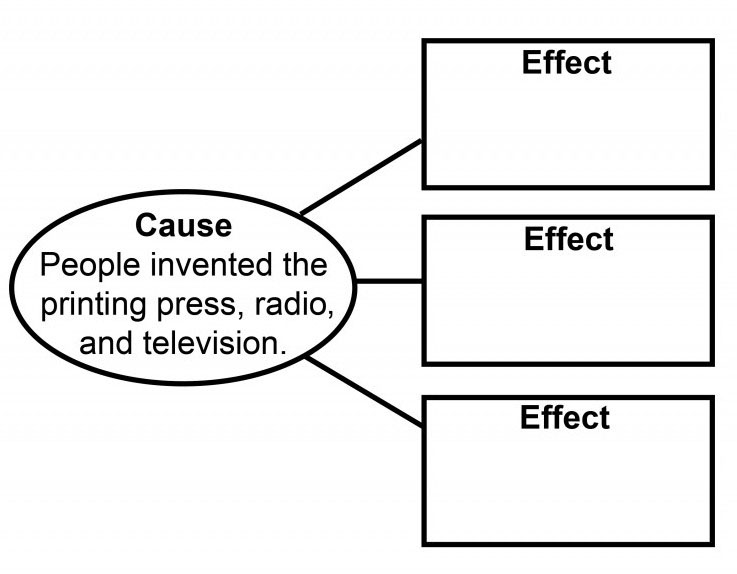Storytelling Goes Digital
Learning Goals
In this chapter, you will learn to:
- Use your own experience to decide if information is accurate
- Use the affixes extra-, -or, -tion, and -al
- Identify cause and effect
- Discuss and respond to the digital story All the Truly Important Things
- Recognize the sequence of events
- Identify the subject and verb in a sentence
- Use pronouns correctly
- Write an opinion paragraph

Get Ready to Read
- How did you experience stories as a child? How is this different from the way that children today experience stories?
- What is your favourite way to experience a story: in person or through books, TV, radio, or video games?
- We need stories that are windows into new worlds as well as mirrors of our own worlds. Do you think that there are enough stories that mirror, or reflect, your cultural background and experiences?
Vocabulary
Readers sometimes scan a text for specific information rather than reading every word. When you scan a text, choose a word to look for. Then run your eyes quickly over many lines to find that word.
Scan Storytelling Goes Digital to find a bold word for each of the following.
1. A way of seeing and understanding the world
2. An extremely small living thing that can spread from one animal to another and can cause illness
3. Connected to the Internet
4. Normal or usual
5. Someone who has a lot of experience using a skill for their job
6. Something that is created by people
7. The part or job someone has in a family, community, or group
8. To cause two or more things to be together
9. To say something out loud for an audience
10. To show respect for someone or something
Word Patterns
extra– is a prefix that means “beyond”
–or is a suffix that means “one who”
–tion is a suffix that means “the act of”
–al is a suffix that means “related to”
Use the vocabulary words and affixes above to build a word for each definition below.
11. ___________________________: one who invents
12. ___________________________: related to a virus
13. ___________________________: the act of combining
14. ___________________________: beyond ordinary
Reading Strategy
Readers check their understanding of a text while they read. In this book, you will practice strategies for checking whether you are really thinking about the words on a page. One strategy is to stop after each paragraph and ask yourself: Can I picture what the text is describing, like a movie playing in my mind? If you can’t picture it, then go back and try to visualize as you re-read the paragraph. If you like to draw, you can even doodle the pictures you see in your mind in the space beside the paragraph.
Try this strategy as you read Storytelling Goes Digital.
Check Your Understanding
1. A cause is a reason something happens. An effect is what happens. People invented the printing press, radio, and television. Name three effects of these inventions.

2. What three examples of professional storytellers are mentioned in the text?
3. What is a digital story?
4. Stories are usually told from the point of view of an author or a character. Point of view refers to the way someone sees and understands the world. Storytelling Goes Digital says that not enough stories are told from the points of view of women, working class people, queer and trans people, and people with disabilities. Do you think this is accurate, based on stories you’ve seen in movies, books, TV shows, and video games? Can you think of other groups that don’t have enough stories told from their point of view?

5. Below are six main events from the digital story All the Truly Important Things. The events are not in the correct sequence, or order. Put the events in the correct sequence.
a. A doctor told Eric, “All the truly important things in life, you haven’t lost.” Eric did not believe the doctor.
b. Eric trained to be a doctor for people with HIV.
c. Eric was diagnosed with HIV and felt lost.
d. Eric became a doctor to a person who had just been diagnosed with HIV. Eric told him, “All the truly important things in life, you haven’t lost.”
e. Someone asked Eric if it was hard for him to work with people with HIV, since he also has HIV. Eric realized it was deeply joyful to be able to give people hope. He realized what his doctor had said was true.
f. Eric graduated from medical school and moved to San Francisco to find love.
Subjects and Verbs
Grammar Rule
The subject of a sentence is the person, place, thing, or idea doing the action. Sometimes the subject’s action is simply being or having.
- The subject can be a person:
Example: Queen Elizabeth I had more than two thousand dresses.
- The subject can be a place:
Example: Indiana has a town named Santa Claus.
- The subject can be a thing:
Example: The Bible is the most shoplifted book in America.
Look at these sentences. Underline the subjects.
1. Your thumb is the same length as your nose.
2. Twins do not have the same fingerprints.
3. It is impossible to sneeze with your eyes open.
4. An eyebrow has about 450 hairs.
5. Canada has more doughnut shops per person than anywhere else in the world.
6. Fortune cookies were invented in Los Angeles.
7. At 122 years old, Jeanne Calment lived the longest life of any human.
8. Every morning, I wake up to the sound of a rooster crowing.
Grammar Rule
- A verb is often an action word. The action verbs in the sentences below are underlined.
Example: I washed the dishes. Then I mopped the floor.
- Some verbs can be tricky to identify because they don’t seem like actions. For example, be and have are verbs. These verbs have many different forms. Forms of be include is, am, are, was, were, and will be. Forms of have include has, had, and will have.
Example: I am 50 years old.
Example: Bob has a small cabin in the woods.
- Some verbs are two, three, or four words long! These verbs have a main verb and some helping verbs. Words like can, could, should, may, might, will, would, and must are helping verbs.
Examples:
I will follow you into the dark.
The baby should go to bed.
He has been playing piano for three hours.
Underline the verbs in these sentences.
9. Grapes explode when you put them in the microwave.
10. Before birth, chicks can talk to each other from inside their eggs.
11. Antarctica has one ATM machine.
12. Paper was invented in China.
13. Scientists are building a car-plane.
14. The thunder will scare the dog.
15. I have been working at the same job for 20 years.
16. The comet flew across the night sky.
17. The child spilled his milk all over the floor.
18. We will dance all night long.
19. The bottle had a message in it.
20. The X-ray shows that your finger is broken.
Pronouns
Grammar Rule
A pronoun is a word that takes the place of a noun. Look at the two groups of sentences below. Which one sounds better?
- Eric is a doctor who has HIV. Eric treats other people who have HIV. Eric helps them feel hopeful. Recently, Eric made a digital story about his journey.
- Eric is a doctor who has HIV. He treats other people who have HIV. He helps them feel hopeful. Recently, he made a digital story about his journey.
In the first group of sentences, it sounds strange to keep repeating the name Eric. In the second group of sentences, the pronoun he took the place of the noun Eric. The language flows more smoothly. Pronouns let us avoid repeating the name of a person, place, or thing.
He, she, they, we, and it are pronouns that can replace a subject — the person, place, or thing doing an action.
Replace the subject in the second sentence with the correct pronoun.
1. Tanya Tagaq is a singer from Nunavut. Tanya performs a style of music called Inuit throat singing.
2. Taté BlackBear is from the Lakota Nation. Taté knows seven words in the Lakota language.
3. Evan Adams and Adam Beach starred in a movie called Smoke Signals. Evan Adams and Adam Beach are both actors from Canada.
4. Thomas King and I have something in common. Thomas King and I are both writers.
5. Louis Riel was the father of Manitoba. Louis Riel was also the leader of the Métis people on the Canadian prairies.
6. Coyote and Raven are found in many Aboriginal stories. Coyote and Raven are famous for playing tricks on others.
7. Sweetgrass is a sacred plant in First Nations cultures. Sweetgrass is known for its ability to heal and get rid of negative thoughts.

Grammar Rule
In the above exercises, you learned that he, she, they, we, and it are pronouns that can replace a subject — the person, place, or thing doing an action.
Me, him, her, them, it, and us are pronouns that replace the person or thing receiving the action.
Fill in the blanks with the correct pronouns. Underline the noun it replaces.
Example:
- I own that book, but I have not read ________ yet.
- I own that book, but I have not read ___it___ yet.
8. Jack ate the apple, even though it did not belong to ____________.
9. The kids had to go to bed by 8:00 p.m. Their parents would not let ___________ stay up any later.
10. The shirt fits me, but I probably won’t wear _____________.
11. Billie and I are going to the movies. Do you want to come with ____________?
12. I want to know how to get to Nanaimo. Will you tell ____________?
13. Sue just got an iPhone. Sam gave it to _______________.
Writing
During your time as a student, you will likely be asked to write many kinds of paragraphs. In this book, you will learn how to write paragraphs that describe things, explain how to do things, tell a story, or give an opinion. No matter what kind of writing task you are working on, there is a strategy you can use to stay on track. It’s called TOWER. The letters in TOWER stand for Think, Organize, Write, Edit, and Rewrite.
Writing Task
“Thomas King is the best storyteller in the world.”
“Movies and television shows do not have enough main characters with disabilities.”
“Canada needs more Canadian television shows.”
Each of the above statements is an opinion. Unlike a fact, an opinion is something that people may agree or disagree about. An opinion paragraph is a group of sentences that state an opinion and explain your position. The author may want to convince the reader to agree with him or her. To be convincing, the paragraph will usually give at least three reasons, facts, or examples that support the belief.
Follow the steps below to write an opinion paragraph on this topic.
Imagine a world with no Internet. In your opinion, would the world be a better place or a worse place? Give reasons for your opinion.
1. Think: Try free-writing about this topic for five minutes. Free-writing is an activity where you write everything that comes to your mind. Don’t stop writing, even for a second. Don’t worry about grammar or whether your ideas are any good. The point of free-writing is to come up with as many ideas as possible. When five minutes are up, look back at the ideas you came up with. It’s time to make some decisions. What will your opinion be? Do you think the world would be a better place without the Internet? Are there any details you want to use from your free-writing to support your opinion? Can you think of any additional ideas to support your opinion?
2. Organize: Ask your instructor for the Paragraph Outline worksheet, or open and print one from the link. You will also find a printable version in Appendix 1. Fill in the outline with your best ideas.
3. Write: Follow your outline as you write a first draft of your opinion paragraph. Don’t worry too much about spelling and grammar. Just get your ideas down in a way that makes sense. At this point, you may want to put your draft aside so you can look at it with fresh eyes later.
4. Edit: Use a different colour to make edits to your writing. Check to see how it sounds when you read it out loud. Is the meaning clear? Are there any details that are missing or off topic? Should you use different sentence types to make it flow more smoothly? Are there any words that you want to change to make your writing more alive? (Use a thesaurus to find more interesting vocabulary words.) Are all your sentences complete? Do you need to check the spelling of any words in a dictionary?
5. Rewrite: Write a final copy of your paragraph that includes all your edits. You may wish to type it on a computer. Finally, hand it in to your instructor.
Answer Key
| Vocabulary | |
| QUESTION | ANSWER |
| 1 | point of view |
| 2 | virus |
| 3 | online |
| 4 | ordinary |
| 5 | professional |
| 6 | invention |
| 7 | role |
| 8 | combine |
| 9 | recite |
| 10 | honour |
| 11 | inventor |
| 12 | viral |
| 13 | combination |
| 14 | extraordinary |
| Check Your Understanding | |
| QUESTION | ANSWER |
| 1 | These inventions made it possible to share stories with a large audience around the world. Storytelling became a job for professionals. Big companies got to decide whose stories would be told, and some voices were left out. |
| 2 | Three examples of professional storytellers are mentioned in the text are authors, journalists, and filmmakers. |
| 3 | A digital story is a short movie made by an ordinary person. It combines images and sound to tell a story about that person’s life. |
| 4 | Answers will vary. |
| 5 | f, c, a, b, e, d |
| Subjects and Verbs | |
| QUESTION | ANSWER |
| 1 | Your thumb is the same length as your nose. |
| 2 | Twins do not have the same fingerprints. |
| 3 | It is impossible to sneeze with your eyes open. |
| 4 | An eyebrow has about 450 hairs. |
| 5 | Canada has more doughnut shops per person than anywhere else in the world. |
| 6 | Fortune cookies were invented in Los Angeles. |
| 7 | At 122 years old, Jeanne Calment lived the longest life of any human. |
| 8 | Every morning, I wake up to the sound of a rooster crowing. |
| 9 | Grapes explode when you put them in the microwave. |
| 10 | Before birth, chicks can talk to each other from inside their eggs. |
| 11 | Antarctica has one ATM machine. |
| 12 | Paper was invented in China. |
| 13 | Scientists are building a car-plane. |
| 14 | The thunder will scare the dog. |
| 15 | I have been working at the same job for 20 years. |
| 16 | The comet flew across the night sky. |
| 17 | The child spilled his milk all over the floor. |
| 18 | We will dance all night long. |
| 19 | The bottle had a message in it. |
| 20 | The X-ray shows that your finger is broken. |
| Pronoun Reference | |
| QUESTION | ANSWER |
| 1 | Tanya Tagaq is a singer from Nunavut. She performs a style of music called Inuit throat singing. |
| 2 | Tate BlackBear is from the Lakota Nation. He knows seven words in the Lakota language. |
| 3 | Evan Adams and Adam Beach starred in a movie called Smoke Signals. They are both actors from Canada. |
| 4 | Thomas King and I have something in common. We are both writers. |
| 5 | Louis Riel was the father of Manitoba. He was also the leader of the Métis people on the Canadian prairies. |
| 6 | Coyote and Raven are found in many Aboriginal stories. They are famous for playing tricks on others. |
| 7 | Sweetgrass is a sacred plant in First Nations cultures. It is known for its ability to heal and get rid of negative thoughts. |
| 8 | Jack ate the apple, even though it did not belong to him. |
| 9 | The kids had to go to bed by 8 p.m. Their parents would not let them stay up any later. |
| 10 | The shirt fits me, but I probably won’t wear it. |
| 11 | Billie and I are going to the movies. Do you want to come with us? |
| 12 | I want to know how to get to Nanaimo. Will you tell me? |
| 13 | Sue just got an iPhone. Sam gave it to her. |
Attributions
Story book
Image by bennimax is in the public domain.
Digital stories
Image by gr8effect is in the public domain.
Tanya Tagaq
Tanya Tagaq by Martica1974 is used under a CC BY SA 3.0 license.

